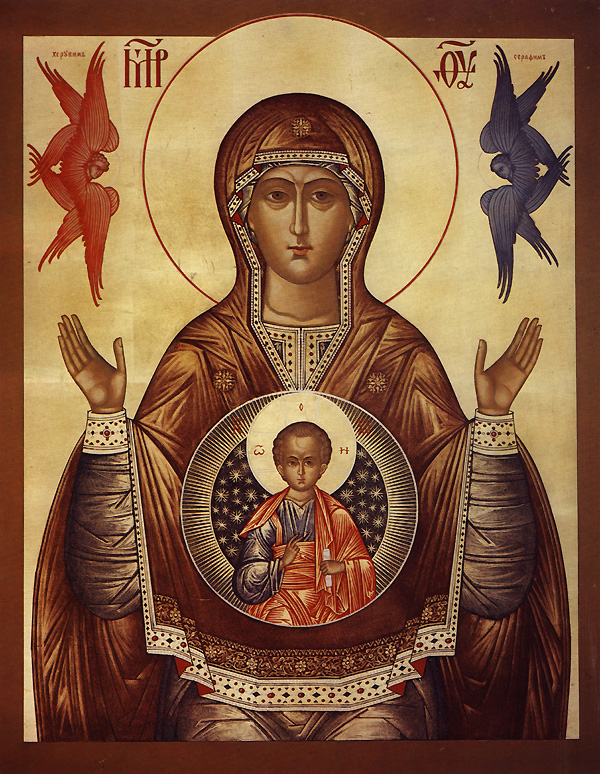
One of the most inspiring days preceding Christmas is the feast of “Our Lady of Expectation” unknown to many today but still kept alive in many countries like Spain, Portugal, Italy and Poland as well as in a few religious orders. In older editions of missals, this feast is still listed as a votive Mass. The feast is celebrated on the 18 December, a week before Christmas Day.
Canadian blogger Vox Cantoris once made an eloquent commentary of the time: “The machinations of Annibale Bugnini were well on their way in the middle 1950’s with the planned reforms given to us by Pope John XXIII in the Missal of 1962 revisions. There was a removal of certain Octaves, a simplification of Feasts and a virtual elimination of Commemorations. It was an easy target for the radical reformers and because we are frozen at 1962 as per Summorum Pontificum, you might only hear them at Mass in an independent chapel that might refuse the Missal of 1962. The Society of St. Pius X, Fraternity of St. Peter would follow 1962.”
Our Blessed Lady, well advanced in pregnancy, is portrayed in the highest dignity of her Divine Motherhood. Dressed in royal apparel as daughter of David the King, she awaits with joy the arrival of her divine Son, Jesus, the Prince of Peace. Her whole posture suggests how she remains wholly consumed in contemplation of her Son under her heart. Her immaculate womb has become a living portable sanctuary of divinity.
There are special prayers and novenas to “Our Lady of Expectation” available for women who cannot conceive or bear a child. Many believe the icon of the Mother of God “Of the Sign” depicts the mystery of the Nativity of Christ. This type of image of the Theotokos was already evident in the catacombs of the first Christians. Many copies of the this Icon were made and have received prominence in Russia. Many of them have shone with miracles in local churches and received fame as a place of miracles.
Adapted from “The Liturgical Year” by Abbot Gueranger
This feast, which in recent times has been kept not only throughout the whole of Spain, but also in many other parts of the Catholic world, owes its origin to the bishops of the 10th Council of Toledo, in 656. These prelates thought that there was an incongruity in the ancient practice of celebrating the Feast of the Annunciation on the 25th of March, inasmuch as this joyful solemnity frequently occurs at the time when the Church is intent upon the Passion of Our Lord, so that it is sometimes obliged to be transferred into Easter time, with which it is out of harmony for another reason. They therefore decreed that, henceforth, in the Church of Spain there should be kept, eight days before Christmas, a solemn Feast with an octave, in honor of the Annunciation, and as a preparation for the great solemnity of Our Lord’s Nativity. In the course of time, however, the Church of Spain saw the necessity of returning to the practice of the Church of Rome and of the whole world, which solemnize the 25th of March as the day of Our Lady’s Annunciation and the Incarnation of the Son of God. But such had been, for ages, the devotion of the people for the Feast of the 18th of December, that it was considered requisite to maintain some vestige of it. They discontinued, therefore, to celebrate the Annunciation on this day; but the faithful were requested to consider, with devotion, what must have been the sentiments of the Holy Mother of God during the days immediately preceding Her giving Him birth. A new Feast was instituted, under the name of “the Expectation of the Blessed Virgin’s Delivery.”
This Feast, which sometimes goes under the name of Our Lady of O, or the Feast of O, on account of the great antiphons which are sung during these days, and, in a special manner, of that which begins O Virgo virginum (which is still used in the Vespers of the Expectation—see below, together with the O Adonai, the antiphon of the Advent Office), was kept with great devotion in Spain. A High Mass was sung at a very early hour each morning during the octave, at which all who were with child, whether rich or poor, considered it a duty to assist, that they might thus honor Our Lady’s Maternity, and beg Her blessing upon themselves. It is no wonder that the Holy See approved of this pious practice being introduced into almost every other country. We find that the Church of Milan, Whose Advent fast lasted 40 days, long before Rome conceded this Feast to the various dioceses of Christendom, celebrated the Office of Our Lady’s Annunciation on the sixth and last Sunday of Advent, and called the whole week following the Hebdomada de Exceptato (for thus the popular expression had corrupted the word Expectato). But it, too, has given way to the Feast of Our Lady’s Expectation, which the Church has established and sanctioned as a means of exciting the attention of the faithful during these last days of Advent.
Most just indeed it is, O Holy Mother of God, that we should unite in that ardent desire Thou hadst to see Him, Who had been concealed for nine months in Thy chaste womb; to know the features of this Son of the Heavenly Father, Who is also Thine; to come to that blissful hour of His birth, which will give glory to God in the highest, and on earth, peace to men of good will. Yes, dearest Mother, the time is fast approaching, though not fast enough to satisfy Thy desires and ours. Make us redouble our attention to the great mystery; complete our preparation by Thy powerful prayers for us, that when the solemn hour has come, our Jesus may find no obstacle to His entrance into our hearts.
O Virgin of virgins! How shall this be? For never was there one like Thee, nor will there ever be. Ye daughters of Jerusalem, why look ye wondering at Me? What you behold is a divine mystery.
The Votive Mass
The votive Mass of “Our Lady of Expectation” is theologically enlightening and spiritually enriching for the time of Advent and Christmas. With the entrance antiphon, the Church prays with the prophet for the coming of the Just One from heaven that the earth may be ready to welcome the Savior: “Send victory like a dew, you heavens, and let the clouds rain down the just. Let the earth open for salvation to spring up” (Is 45:8). In the opening prayer, the Church offers the prayer to God through Mary’s intercession: “O God who wished that your Word would take the flesh from the womb of the Virgin as announced by the Angel and whom we confess to be the true Mother of God, may we be helped by her intercession.
INTROIT
Isa. 45:8 Drop down dew, you heavens, from above, and let the clouds rain the just one. Let the earth be opened and bud forth a Saviour.
Ps. 18:2. The heavens show forth the glory of God, and the firmament proclaims His handiwork.
℣. Glory be . . .
COLLECT
O God, Who didst will that at the message of an angel Thy word should take flesh in the womb of the Blessed Virgin Mary: grant that we, Thy suppliants, who believe her to be truly the Mother of God, may be helped by her intercession with Thee. Through the same Jesus Christ, Thy Son, Who liveth and reigneth with Thee in the unity of the Holy Ghost, God,
world without end.
℟. Amen.
Let us pray.
Lend Your ear to our prayers, O Lord, we beseech You; and brighten the darkness of our minds by the grace of Your coming.
Who livest and reignest with God the Father, in the unity of the Holy Ghost, one God, world without end.
℟. Amen
Lesson
Lesson from the letter of St Paul the Apostle to the Philippians
Phil 4:4-7
Brethren: Rejoice in the Lord always; again I say, rejoice. Let your moderation be known to all men. The Lord is near. Have no anxiety, but in every prayer and supplication with thanksgiving let your petitions be made known to God. And may the peace of God which surpasses all understanding guard your hearts and your minds in Christ Jesus, our Lord.
℟. Thanks be to God.
Gradual
Ps 79:2-3, 2.
From Your throne, O Lord, upon the Cherubim, rouse Your power, and come.
℣. O Shepherd of Israel, hearken, O Guide of the flock of Joseph!
Isa. 45:8 Drop down dew, you heavens, from above, and let the clouds rain the just one. Let the earth be opened and bud forth a Saviour.
Ps. 18:2. The heavens show forth the glory of God, and the firmament proclaims His handiwork.
℣. Glory be . . .
COLLECT
O God, Who didst will that at the message of an angel Thy word should take flesh in the womb of the Blessed Virgin Mary: grant that we, Thy suppliants, who believe her to be truly the Mother of God, may be helped by her intercession with Thee. Through the same Jesus Christ, Thy Son, Who liveth and reigneth with Thee in the unity of the Holy Ghost, God,
world without end.
℟. Amen.
Let us pray.
Lend Your ear to our prayers, O Lord, we beseech You; and brighten the darkness of our minds by the grace of Your coming.
Who livest and reignest with God the Father, in the unity of the Holy Ghost, one God, world without end.
℟. Amen
Lesson
Lesson from the letter of St Paul the Apostle to the Philippians
Phil 4:4-7
Brethren: Rejoice in the Lord always; again I say, rejoice. Let your moderation be known to all men. The Lord is near. Have no anxiety, but in every prayer and supplication with thanksgiving let your petitions be made known to God. And may the peace of God which surpasses all understanding guard your hearts and your minds in Christ Jesus, our Lord.
℟. Thanks be to God.
Gradual
Ps 79:2-3, 2.
From Your throne, O Lord, upon the Cherubim, rouse Your power, and come.
℣. O Shepherd of Israel, hearken, O Guide of the flock of Joseph!
GOSPEL
Continuation ☩ of the Holy Gospel according to John
℟. Glory be to Thee, O Lord.
John 1:19-28
At that time, the Jews sent to John from Jerusalem priests and Levites to ask him, Who are you? And he acknowledged and did not deny; and he acknowledged, I am not the Christ. And they asked him, What then? Are you Elias? And he said, I am not. Are you the Prophet? And he answered, No. They therefore said to him, Who are you? that we may give an answer to those who sent us. What have you to say of yourself? He said, I am the voice of one crying in the desert, ‘Make straight the way of the Lord,’ as said Isaias the prophet. And they who had been sent were from among the Pharisees. And they asked him, and said to him, Why, then, do you baptize, if you are not the Christ, nor Elias, nor the Prophet? John said to them in answer, I baptize with water; but in the midst of you there has stood One Whom you do not know. He it is Who is to come after me, Who has been set above me, the strap of Whose sandal I am not worthy to loose. These things took place at Bethany, beyond the Jordan, where John was baptizing.
SECRET
Strengthen in our minds, O Lord, we beseech Thee, the mysteries of the true faith, that, confessing Him Who was conceived of the Virgin to be true God and true man, we may deserve, through the power of His saving resurrection, to attain everlasting joy. Through the same Lord Jesus Christ, Thy Son, Who liveth and reigneth with Thee in the unity of the Holy Ghost, God, Forever and ever.
℟. Amen.
We beseech You, O Lord, that the gift we dedicate to You, may be sacrificed continually, so that the sacramental rite You have ordained may be fully observed, and the work of Your salvation may be wonderfully effective within us.
Through Jesus Christ, thy Son our Lord, Who liveth and reigneth with thee, in the unity of the Holy Ghost, ever one God, world without end.
℟. Amen.
POSTCOMMUNION
Pour forth, we beseech Thee, O Lord, Thy grace into our hearts, that we, to whom the incarnation of Christ Thy Son was made known by the message of an angel, may, by His passion and cross, be brought to the glory of His resurrection. Through the same Lord Jesus Christ, Thy Son, Who liveth and reigneth with Thee in the unity of the Holy Ghost, one God
Forever and ever.
℟.. Amen.
We entreat You, merciful Lord, that these divine helps may cleanse us from our sins and prepare us for the coming festal season.
Through Jesus Christ, thy Son our Lord, Who liveth and reigneth with thee, in the unity of the Holy Ghost, ever one God, world without end.
℟. Amen.
Our Lady of Expectation: Pray for us!

-
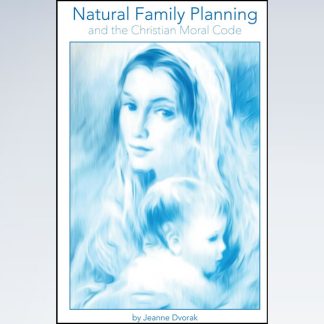 Natural Family Planning and the Christian Moral CodeUS$ 14.00
Natural Family Planning and the Christian Moral CodeUS$ 14.00 -
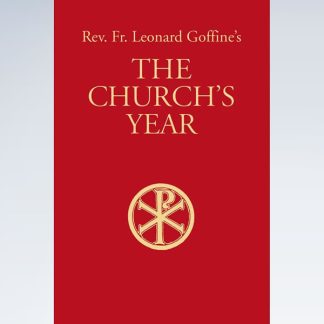 The Church’s YearUS$ 52.00
The Church’s YearUS$ 52.00 -
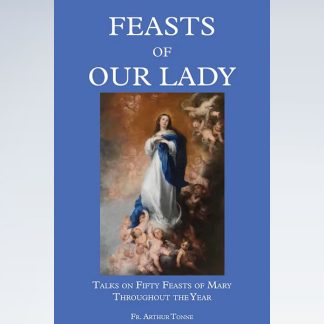 Feasts of Our Lady – Homilies by Fr. Arthur TonneUS$ 18.00
Feasts of Our Lady – Homilies by Fr. Arthur TonneUS$ 18.00 -
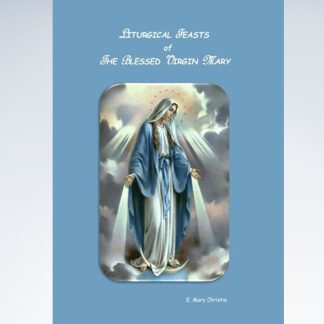 Liturgical Feasts of The Blessed Virgin MaryUS$ 18.00
Liturgical Feasts of The Blessed Virgin MaryUS$ 18.00 -
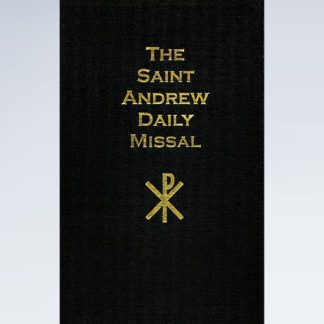 The Saint Andrew Daily Missal 1945 Edition (Gold Edges)US$ 82.00
The Saint Andrew Daily Missal 1945 Edition (Gold Edges)US$ 82.00 -
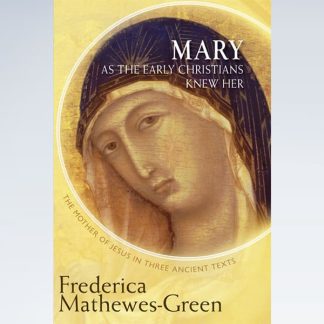 Mary As the Early Christians Knew HerUS$ 22.00
Mary As the Early Christians Knew HerUS$ 22.00
VIRGÓ SACRÁTA is a Christian mission-driven online resource and shop inspired from the beauty of Catholic faith, tradition, and arts. Our mission is to “Restore All Things to Christ!”, in continuing the legacy of Pope St. Pius X under the patronage of the Blessed Virgin Mary. “Who is she that cometh forth as the morning rising, fair as the moon, bright as the sun, terrible as an army set in battle array?” O Mary, conceived without sin, pray for us who have recourse to Thee.


